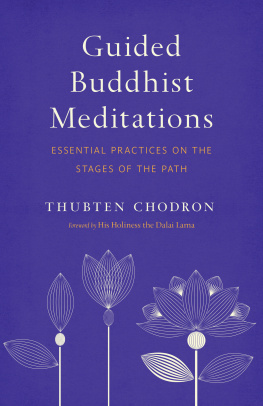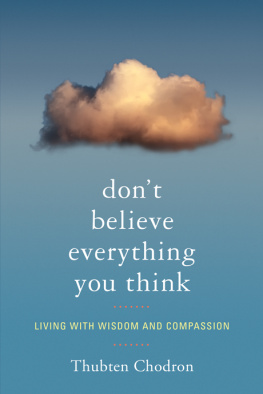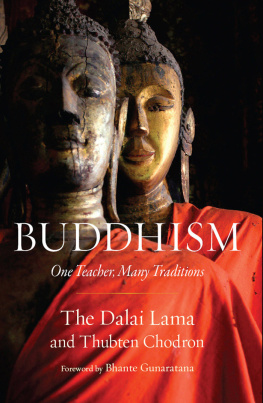Thubten Chodron - Buddhism For Beginners
Here you can read online Thubten Chodron - Buddhism For Beginners full text of the book (entire story) in english for free. Download pdf and epub, get meaning, cover and reviews about this ebook. City: Ithaca, N.Y, year: 2001, publisher: Snow Lion, genre: Religion. Description of the work, (preface) as well as reviews are available. Best literature library LitArk.com created for fans of good reading and offers a wide selection of genres:
Romance novel
Science fiction
Adventure
Detective
Science
History
Home and family
Prose
Art
Politics
Computer
Non-fiction
Religion
Business
Children
Humor
Choose a favorite category and find really read worthwhile books. Enjoy immersion in the world of imagination, feel the emotions of the characters or learn something new for yourself, make an fascinating discovery.
- Book:Buddhism For Beginners
- Author:
- Publisher:Snow Lion
- Genre:
- Year:2001
- City:Ithaca, N.Y
- Rating:5 / 5
- Favourites:Add to favourites
- Your mark:
- 100
- 1
- 2
- 3
- 4
- 5
Buddhism For Beginners: summary, description and annotation
We offer to read an annotation, description, summary or preface (depends on what the author of the book "Buddhism For Beginners" wrote himself). If you haven't found the necessary information about the book — write in the comments, we will try to find it.
Buddhism For Beginners — read online for free the complete book (whole text) full work
Below is the text of the book, divided by pages. System saving the place of the last page read, allows you to conveniently read the book "Buddhism For Beginners" online for free, without having to search again every time where you left off. Put a bookmark, and you can go to the page where you finished reading at any time.
Font size:
Interval:
Bookmark:

Blossoms of the Dharma: Living as a Buddhist Nun
(North Atlantic Books, Berkeley CA)
Choosing Simplicity
by Venerable Master Wu Yin, ed. by Thubten Chodron
(Snow Lion Publications, Ithaca NY)
Interfaith Insights
(Timeless Books, New Delhi)
Open Heart, Clear Mind
(Snow Lion Publications, Ithaca NY)
Taming the Monkey Mind
(Heian International, Torrance CA)
Transforming the Heart: The Buddhist Way to Joy and Courage, by Geshe Jampa Tegchok, ed. by Thubten Chodron
(Snow Lion Publications, Ithaca NY)
by Thubten Chodron

I am happy to know about this book, Buddhism for Beginners, by Thubten Chodron. This book is written mainly for people wanting to understand basic Buddhist principles and how to integrate them into their lives. It might be useful if I mention a few words here about what should be their approach to Buddhism. In the beginning one should remain skeptical and rely on questioning and checking the teachings based on one's understanding. One can then have trust and confidence in the teachings. Buddha himself suggested this approach when he told his followers to accept his teaching after due analysis, and not merely out of respect and faith. Hence it is important to know that the main cause of faith is reflecting on reasons. This promotes conviction and helps develop actual experience. As one thinks more and more upon reasonings, one's ascertainment increases, and this in turn, induces experience, whereby faith becomes more firm.
His Holiness the Fourteenth Dalai Lama
I had been in Singapore just a few days when a young man appeared at my door. "Can I ask you some questions about Buddhism?" he queried. We sat down and began to talk. Some of his questions were those also asked by Westerners new to Buddhism. Others were unique to Asians who had grown up in societies where Buddhism and the old folk religions were often mixed, at least in the minds of the general population. As I began teaching in Singapore, I noticed that many people had the same questions.
Soon thereafter, another man came to see me, and in the course of our discussion he said, "We need to hear about the Buddha's teachings in everyday English, a clear explanation without a lot of Pali and Sanskrit terms that we don't understand. Please write a book that will help us. I'd be happy to help you."
The idea for this book came from these two people: Lee Siew Cheung and Robert Gwee. It was initially printed privately in Singapore by Amitabha Buddhist Centre in 1988 and was entitled I Wonder Why. As people read it, they sent me more questions, which are included in the present edition.
Asking questions is healthy. It enables us to clarify doubts and gain new information. Many people have similar questions, and asking our questions is generally appreciated by fellow students who were too shy to ask! However, I believe that spiritual practice is more about holding questions than finding answers. Seeking one correct answer often comes from a wish to make life-which is basically fluid-into something certain and fixed. This often leads to rigidity, closed-mindedness, and intolerance. On the other hand, holding a question-exploring its many facets over time-puts us in touch with the mystery of life. Holding questions accustoms us to the ungraspable nature of life and enables us to understand things from a range of perspectives. Thus, although answers are seemingly given to questions in this book, we must contemplate both, turning them over again and again so we see them from many sides and integrate them into our lives.
This book is designed for people who are interested in Buddhism as well as those who have studied or practiced it for years but are still unclear about some points. The way some of the initial material on Buddhism was translated in the West decades ago has led to misinterpretations even among those who teach Buddhism at the high school and college levels. I hope that this book will help those teachers and their students.
You can read this book from cover to cover or go directly to the sections that interest you. This book is not designed to be a comprehensive introduction to Buddhism, but to clarify points, provide Buddhist perspectives on modern issues, and stimulate the curiosity and questioning minds of the readers.
My deepest respect and gratitude are offered to the Buddhas. I would like to thank all of my teachers, in particular His Holiness the Dalai Lama, Tsenzhab Serkong Rinpoche, and Zopa Rinpoche, for their teachings and guidance. I appreciate the members of Amitabha Buddhist Center in Singapore and Dharma Friendship Foundation in Seattle for their inspiration and help in writing this book. Special thanks go to Monica Faulkner for her help in editing the manuscript. All errors are my own.
"He" and "she" are used interchangeably for the third person pronoun. "Mind," "mindstream," and "consciousness" are used interchangeably to refer to the part of us that perceives and experiences. This includes what we call "heart" in the West. In Buddhism, one word encompasses the meaning of heart and mind. "The Buddha" refers to the historical Buddha, Shakyamuni, who lived in India over 2,500 years ago. "Buddhas" refers to all enlightened beings, of whom Shakyamuni is one.
I have tried to define Buddhist terms as they arise in the text. A glossary at the end of the book is also provided.
Thubten Chodron
Seattle, WA
June 16, 2000
Simply speaking, it is to avoid harming others and to help them as much as possible. Another way of expressing this is the oft-quoted verse:
By abandoning negative actions, such as hurting others, and destructive motivations, such as anger, attachment, and closedmindedness, we stop harming ourselves and others. By creating perfect virtue, we develop beneficial attitudes, such as equanimity, love, compassion, and joy, and act constructively. By subduing our minds and understanding reality, we leave behind all false projections, thus making ourselves calm and peaceful.
We can also speak of the essence of the Buddha's teachings as they are explained in the Four Noble Truths: the truth of suffering, the cause of suffering, the cessation of suffering and its causes, and the path to that cessation. When Buddha spoke about suffering, he meant that we have unsatisfactory experiences. Even the happiness we have does not last forever, and that situation is unsatisfactory. The causes of our problems lie not in the external environment and those inhabiting it, but in our own mind. The disturbing attitudes and negative emotions, such as clinging attachment, anger, and ignorance are the real source of our unhappiness. Since these are based on misconceptions about the nature of reality, they can be removed from our mindstream. We then abide in the blissful state of nirvana, which is the absence of all unsatisfactory experiences and their causes. A path exists to realize reality and increase our good qualities. The Buddha described this path, and we have the ability to actualize it.
Font size:
Interval:
Bookmark:
Similar books «Buddhism For Beginners»
Look at similar books to Buddhism For Beginners. We have selected literature similar in name and meaning in the hope of providing readers with more options to find new, interesting, not yet read works.
Discussion, reviews of the book Buddhism For Beginners and just readers' own opinions. Leave your comments, write what you think about the work, its meaning or the main characters. Specify what exactly you liked and what you didn't like, and why you think so.













